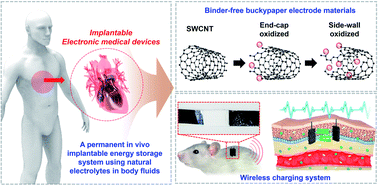A durable high-energy implantable energy storage system with binder-free electrodes useable in body fluids†
Abstract
We developed a flexible supercapacitor (SC) cell with biocompatible oxidized single-walled carbon nanotubes (SWCNTs) driven by electrolytes in body fluids through integration with a wireless sensor network for use in implantable electronic medical devices (IEMDs). The SC was assembled using oxidized SWCNTs (Ox-SWCNTs) in the form of binder-free buckypaper as an electrode material, which is both biocompatible and flexible. The assembled flexible SC cell was operated in a simulated body fluid containing the electrolyte and exhibited an excellent areal capacitance of 51.3 mF cm−2 with ultra-long cycling stability (over 50 000 cycles). Importantly, the developed SC cell attained high energy and power densities of 7.12 mW h cm−2 and 500 mW cm−2, respectively. To verify the applicability of our device as an IEMD, we monitored the long-term stability, safety, and suitability of the buckypaper electrodes for 6 months after transplanting them into mice. The cytotoxicity of Ox-SWCNTs was lower than that of untreated SWCNTs, with no inflammation or fibrotic lesions. In addition to the demonstrated reliability and integration with other electronic components, implantable SCs can be charged via wireless inductive coupling, demonstrating their ability to provide sufficient power for IEMDs.



 Please wait while we load your content...
Please wait while we load your content...